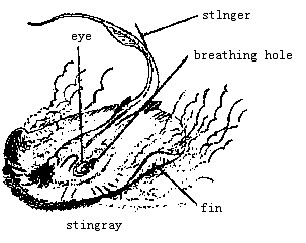阅读理解。
Stingrays (黄貂鱼)
Stingrays are pancake-shaped fish, and you'd never guess it: they're close cousins of sharks.The smallest
kinds are about the size of a dinner plate. But some 4-metre stingrays live in the waters near Australia. About
170 different kinds of stingrays live in the oceans around the world. And some live in freshwater too. In South
America, a few kinds swim in the Amazon and other rivers that flow into the Atlantic. One ocean kind, the
Atlantic stingray, also lives in the St. Johns River in Florida.
A stingray has a mouth and nostrils (鼻孔) on the bottom of its body. These nostrils are for smelling, not
for breathing. When water flows into a stingray's nostrils, the fish may pick up the smells of creatures it wants
to eat. It can also find prey (牺牲者) by sensing the tiny amount of electricity that animals give off. Slowly,
slowly the fish hunts by moving along the ocean or river bottom. When it senses a worm, clam, shrimp, or
other creature, it flaps (拍打) its fins until the prey is uncovered. Then the fish lies down over the prey, sucks
it in, and crunches it with its small teeth. A stingray's flat shape helps it hide. It stirs up a cloud of sand by
flapping its big, flat fins. When the sand settles down over the fish, everything is covered but its eyes,
breathing holes, and sometimes its tail. Its tail gave the"sting" to a stingray's name. When a stingray is attacked
by an enemy, it whips its tail around. Then a sharp stinger releases a powerful poison into the enemy. When
stingrays are on the ocean bottom, it's easy for a diver to step on one by mistake. Then the fish usually stings
the person in the ankle. The poison is very painful, and the wound may hurt for a day or two. Worse yet,
pieces of the stinger can break off and infect the ankle. But stingrays don't chase after prey or people to sting
them. In fact, divers can swim among friendly stingrays without getting hurt.

1. Why did the author write the article "Stingrays"?
A. To tell readers an exciting story about the ocean.
B. To give readers facts about an interesting fish.
C. To warn readers about dangers in the ocean.
D. To teach readers how fish hunt their prey.
2. It is easy for a diver to step on a stingray by mistake because stingrays ______.
A. are of many different sizes
B. can cover themselves with sand
C. move slowly above the ocean floor
D. live in freshwater as well as in oceans
3. Why does a stingray flap its fins when it feels prey?
A. To smell the prey.
B. To escape from the prey.
C. To find the prey.
D. To frighten the prey.
4. How might a sting from a stingray become infected?
A. Poison from the stinger gets into the wound.
B. Pieces of the stinger come loose in the wound.
C. Electricity from the stinger shocks the wound.
D. Fins beside the stinger throw sand into the wound.

